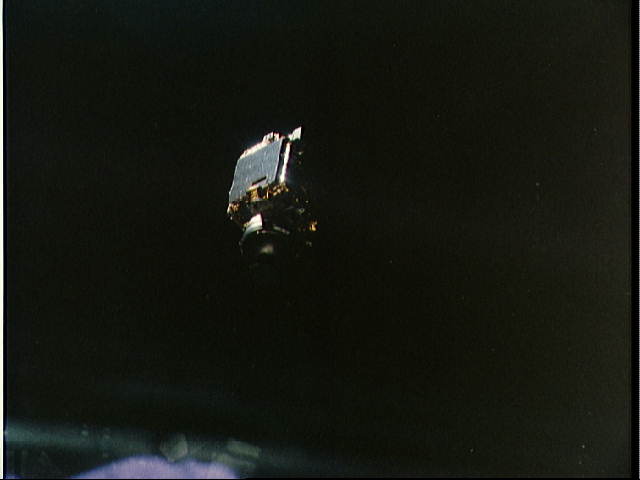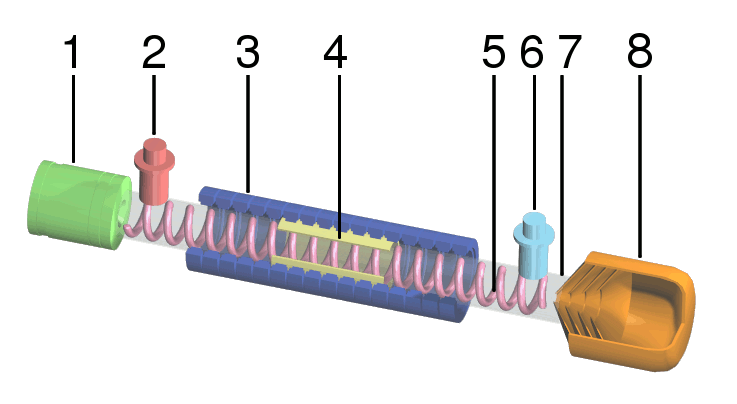|
INSAT-4CR
INSAT-4CR was a communications satellite operated by ISRO as part of the Indian National Satellite System. Launched in September 2007, it replaced the INSAT-4C satellite which had been lost in a launch failure the previous year. The satellite was initially stationed in geostationary orbit at a longitude of 74 degrees east, with expected operational life of at least ten years, however this may have been reduced by the underperformance of the Geosynchronous Satellite Launch Vehicle which placed it into orbit. INSAT-4CR is planned to be replaced by GSAT-31, which was launched on February 6, 2019. Spacecraft INSAT-4CR was constructed by ISRO, and is based around the I-2K satellite bus. A spacecraft, it is equipped with twelve Ku band transponders operating at a frequency of 36 MHz, with 140 Watt travelling wave tube amplifiers. The satellite has an effective isotropic radiated power of 51.5 dBW. An additional Ku band signal is used as a beacon for tracking. INSAT-4CR operat ... [...More Info...] [...Related Items...] OR: [Wikipedia] [Google] [Baidu] |
INSAT Satellites
The Indian National Satellite System or INSAT, is a series of multipurpose geostationary satellites launched by ISRO to satisfy the telecommunications, broadcasting, meteorology, and search and rescue operations. Commissioned in 1983, INSAT is the largest domestic communication system in the Indo-Pacific Region. It is a joint venture of the Department of Space, Department of Telecommunications, India Meteorological Department, All India Radio and Doordarshan. The overall coordination and management of INSAT system rests with the Secretary-level INSAT Coordination Committee. INSAT satellites provide transponders in various bands to serve the television and communication needs of India. Some of the satellites also have the Very High Resolution Radiometer (VHRR), CCD cameras for meteorological imaging. The satellites also incorporate transponder(s) for receiving distress alert signals for search and rescue missions in the South Asian and Indian Ocean Region, as ISRO is a member o ... [...More Info...] [...Related Items...] OR: [Wikipedia] [Google] [Baidu] |
INSAT
The Indian National Satellite System or INSAT, is a series of multipurpose geostationary satellites launched by ISRO to satisfy the telecommunications, broadcasting, meteorology, and search and rescue operations. Commissioned in 1983, INSAT is the largest domestic communication system in the Indo-Pacific Region. It is a joint venture of the Department of Space, Department of Telecommunications, India Meteorological Department, All India Radio and Doordarshan. The overall coordination and management of INSAT system rests with the Secretary-level INSAT Coordination Committee. INSAT satellites provide transponders in various bands to serve the television and communication needs of India. Some of the satellites also have the Very High Resolution Radiometer (VHRR), CCD cameras for meteorological imaging. The satellites also incorporate transponder(s) for receiving distress alert signals for search and rescue missions in the South Asian and Indian Ocean Region, as ISRO is a member o ... [...More Info...] [...Related Items...] OR: [Wikipedia] [Google] [Baidu] |
I-2K
I-2K is a satellite bus developed by Indian Space Research Organisation (ISRO), and marketed by Antrix Corporation. It is a standard bus for 2,000 kg class satellites; the 'I' in I-2K stands for INSAT, a group of communication satellites developed and launched by ISRO. The satellite buses developed by ISRO are specifically developed for small and medium weight satellites. I-2K spacecraft bus can supply DC power up to 3000 watts. I-2K platform is targeted towards satellites in liftoff mass in range of 1500–2500 kg. List of satellites launched using I-2K platform * INSAT series ( 3B 3C 3D 3DR 3E 4C 4CR) * IRS series ( 1C 1D P3) * GSAT series ( 1 2 3 (EDUSAT) 4 5P 6 6A 7 7A 9 14 31) * HYLAS-1 HYLAS (or HYLAS-1) is a British satellite in geostationary orbit. HYLAS, which is an acronym for ''Highly Adaptable Satellite'', is a communications satellite and was launched by the European Ariane 5 launch vehicle from the Guyana Space C ... [...More Info...] [...Related Items...] OR: [Wikipedia] [Google] [Baidu] |
INSAT-4C
INSAT-4C was an Indian communications satellite which was lost in a launch failure in 2006. Had it reached orbit, it would have formed part of the Indian National Satellite System. Launched in 2007, it was intended to have operated in geostationary orbit at a longitude of 73.97° east. The INSAT-4CR satellite, launched in September 2007, replaced it. Built by the Indian Space Research Organisation, INSAT-4C was based upon the I-2K satellite bus. It had a dry mass of , or when fully fuelled. It was expected to have operated for ten years. The satellite carried twelve Ku band transponders, with two solar arrays to generate power. ISRO launched INSAT-4C on the second operational flight of the Geosynchronous Satellite Launch Vehicle, which was flying in the Mk.I configuration. The launch took place from the Second Launch Pad at the Satish Dhawan Space Centre; the first time the pad was used by a GSLV. Liftoff occurred at 12:08 UTC on 10 July 2006. Early in the flight a thru ... [...More Info...] [...Related Items...] OR: [Wikipedia] [Google] [Baidu] |
GSAT-31
GSAT-31 is a high-throughput telecommunication satellite developed by the Indian Space Research Organisation (ISRO). Mission The satellite's main communication payload is Ku band and acts as a replacement of the aging INSAT-4CR. The satellite provides advanced telecommunication to the Indian subcontinent. It is used for VSAT networks, television uplinks, digital signage new gathering, DTH services and other communication systems. This is the 40th communication satellite launched by ISRO and the 22nd launch of ISRO satellite by Arianespace. Launch The satellite was launched through the 103rd flight of Ariane 5 ECA Ariane 5 is a European heavy-lift space launch vehicle developed and operated by Arianespace for the European Space Agency (ESA). It is launched from the Centre Spatial Guyanais (CSG) in French Guiana. It has been used to deliver payloads into ... on 5 February 2019 at 21:01 UTC, the vehicle also deployed Hellas-Sat-4/SaudiGeoSat-1. The launch of the GS ... [...More Info...] [...Related Items...] OR: [Wikipedia] [Google] [Baidu] |
Communications Satellite
A communications satellite is an artificial satellite that relays and amplifies radio telecommunication signals via a transponder; it creates a communication channel between a source transmitter and a receiver at different locations on Earth. Communications satellites are used for television, telephone, radio, internet, and military applications. Many communications satellites are in geostationary orbit above the equator, so that the satellite appears stationary at the same point in the sky; therefore the satellite dish antennas of ground stations can be aimed permanently at that spot and do not have to move to track the satellite. Others form satellite constellations in low Earth orbit, where antennas on the ground have to follow the position of the satellites and switch between satellites frequently. The high frequency radio waves used for telecommunications links travel by line of sight and so are obstructed by the curve of the Earth. The purpose of communicat ... [...More Info...] [...Related Items...] OR: [Wikipedia] [Google] [Baidu] |
Travelling Wave Tube
A traveling-wave tube (TWT, pronounced "twit") or traveling-wave tube amplifier (TWTA, pronounced "tweeta") is a specialized vacuum tube that is used in electronics to amplify radio frequency (RF) signals in the microwave range. The TWT belongs to a category of "linear beam" tubes, such as the klystron, in which the radio wave is amplified by absorbing power from a beam of electrons as it passes down the tube. Although there are various types of TWT, two major categories are: *''Helix TWT'' - in which the radio waves interact with the electron beam while traveling down a wire helix which surrounds the beam. These have wide bandwidth, but output power is limited to a few hundred watts. *''Coupled cavity TWT'' - in which the radio wave interacts with the beam in a series of cavity resonators through which the beam passes. These function as narrowband power amplifiers. A major advantage of the TWT over some other microwave tubes is its ability to amplify a wide range of frequencie ... [...More Info...] [...Related Items...] OR: [Wikipedia] [Google] [Baidu] |
Partial Satellite Launch Failures
Partial may refer to: Mathematics *Partial derivative, derivative with respect to one of several variables of a function, with the other variables held constant ** ∂, a symbol that can denote a partial derivative, sometimes pronounced "partial dee" **Partial differential equation, a differential equation that contains unknown multivariable functions and their partial derivatives Other uses *Partial application, in computer science the process of fixing a number of arguments to a function, producing another function *Partial charge or net atomic charge, in chemistry a charge value that is not an integer or whole number *Partial fingerprint, impression of human fingers used in criminology or forensic science *Partial seizure or focal seizure, a seizure that initially affects only one hemisphere of the brain * Partial or Part score, in contract bridge a trick score less than 100, as well as other meanings * Partial or Partial wave, one sound wave of which a complex tone is composed ... [...More Info...] [...Related Items...] OR: [Wikipedia] [Google] [Baidu] |
Spacecraft Launched In 2007
A spacecraft is a vehicle or machine designed to fly in outer space. A type of artificial satellite, spacecraft are used for a variety of purposes, including communications, Earth observation, meteorology, navigation, space colonization, planetary exploration, and transportation of humans and cargo. All spacecraft except single-stage-to-orbit vehicles cannot get into space on their own, and require a launch vehicle (carrier rocket). On a sub-orbital spaceflight, a space vehicle enters space and then returns to the surface without having gained sufficient energy or velocity to make a full Earth orbit. For orbital spaceflights, spacecraft enter closed orbits around the Earth or around other celestial bodies. Spacecraft used for human spaceflight carry people on board as crew or passengers from start or on orbit (space stations) only, whereas those used for robotic space missions operate either autonomously or telerobotically. Robotic spacecraft used to support scientific r ... [...More Info...] [...Related Items...] OR: [Wikipedia] [Google] [Baidu] |
Graveyard Orbit
A graveyard orbit, also called a junk orbit or disposal orbit, is an orbit that lies away from common operational orbits. One significant graveyard orbit is a supersynchronous orbit well beyond geosynchronous orbit. Some satellites are moved into such orbits at the end of their operational life to reduce the probability of colliding with operational spacecraft and generating space debris. Overview A graveyard orbit is used when the change in velocity required to perform a de-orbit maneuver is too large. De-orbiting a geostationary satellite requires a delta-v of about , whereas re-orbiting it to a graveyard orbit only requires about . For satellites in geostationary orbit and geosynchronous orbits, the graveyard orbit is a few hundred kilometers beyond the operational orbit. The transfer to a graveyard orbit beyond geostationary orbit requires the same amount of fuel as a satellite needs for about three months of stationkeeping. It also requires a reliable attitude control ... [...More Info...] [...Related Items...] OR: [Wikipedia] [Google] [Baidu] |
NASA
The National Aeronautics and Space Administration (NASA ) is an independent agency of the US federal government responsible for the civil space program, aeronautics research, and space research. NASA was established in 1958, succeeding the National Advisory Committee for Aeronautics (NACA), to give the U.S. space development effort a distinctly civilian orientation, emphasizing peaceful applications in space science. NASA has since led most American space exploration, including Project Mercury, Project Gemini, the 1968-1972 Apollo Moon landing missions, the Skylab space station, and the Space Shuttle. NASA supports the International Space Station and oversees the development of the Orion spacecraft and the Space Launch System for the crewed lunar Artemis program, Commercial Crew spacecraft, and the planned Lunar Gateway space station. The agency is also responsible for the Launch Services Program, which provides oversight of launch operations and countdown m ... [...More Info...] [...Related Items...] OR: [Wikipedia] [Google] [Baidu] |





